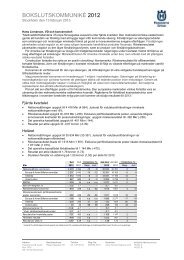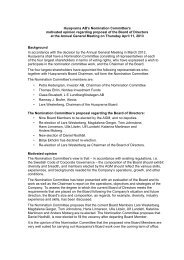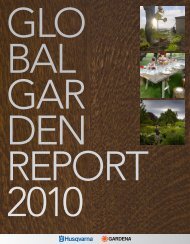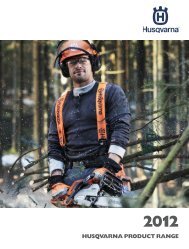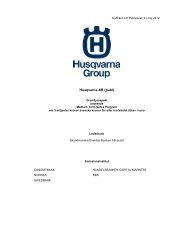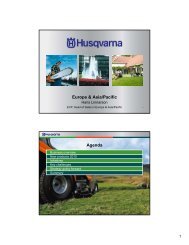Annual Report 2009 - Husqvarna Group
Annual Report 2009 - Husqvarna Group
Annual Report 2009 - Husqvarna Group
Create successful ePaper yourself
Turn your PDF publications into a flip-book with our unique Google optimized e-Paper software.
Notes <strong>Husqvarna</strong> <strong>Annual</strong> <strong>Report</strong> <strong>2009</strong> 61<br />
Amounts in SEKm unless otherwise stated.<br />
Issued – Maturity<br />
Program<br />
Nominal<br />
amount Currency Coupon<br />
CP 0 SEK<br />
2007–2010 MTN 100 SEK STIBOR +0.28%<br />
2007–2010 MTN 350 SEK STIBOR +0.29%<br />
2007–2012 MTN 250 SEK STIBOR +0.39%<br />
2007–2012 MTN 250 SEK 4.875%<br />
2007–2015 MTN 500 SEK STIBOR +0.46%<br />
2008–2016 MTN 60 EUR EURIBOR +0.82%<br />
Currency composition<br />
The currency composition of <strong>Husqvarna</strong>’s borrowings is<br />
dependent upon the currency distribution of the <strong>Group</strong>’s<br />
assets. Currency derivatives are used to obtain the preferred<br />
currency distribution.<br />
Net debt<br />
31 Dec <strong>2009</strong> 31 Dec 2008<br />
Net debt<br />
excl.<br />
currency<br />
swaps<br />
Net debt<br />
incl.<br />
currency<br />
swaps<br />
Net debt<br />
excl.<br />
currency<br />
swaps<br />
Net debt<br />
incl.<br />
currency<br />
swaps<br />
SEK 2,550 –4,096 7,670 –563<br />
EUR 3,429 5,308 6,080 6,792<br />
USD 645 2,977 –255 4,628<br />
JPY –155 833 –89 1,004<br />
AUD –43 460 –14 397<br />
CAD –25 402 –25 236<br />
BRL 163 163 174 174<br />
NOK –21 116 –14 131<br />
HKD 0 98 0 103<br />
Other –194 88 25 650<br />
Total 6,349 6,349 13,552 13,552<br />
Liquid funds<br />
Liquid funds consist of cash and cash equivalent and other<br />
short-term deposits including derivative assets at fair market<br />
value. <strong>Husqvarna</strong>’s goal is that the level of liquid funds,<br />
including unutilized committed credit facilities, shall equal at<br />
least 2.5% of rolling 12-month sales. At year-end, this ratio<br />
was 37.4% (28.6). In addition to this liquidity, the <strong>Group</strong> shall<br />
have sufficient liquid resources to finance the expected seasonal<br />
build-up in working capital during the next 12 months.<br />
Credit risk in liquid funds<br />
Investments in liquid funds are mainly made in interest-bearing<br />
instruments with high liquidity and involve issuers with a<br />
long-term rating of at least A–, as defined by Standard &<br />
Poor’s or similar institutions. The average time to maturity for<br />
the liquid funds was 21 days (29) at the end of <strong>2009</strong>.<br />
Interest rate risks on liquid funds and borrowings<br />
Interest rate risk refers to the adverse effects of changes in<br />
market interest rates on the <strong>Group</strong>’s net income. The main<br />
factor determining this risk is the interest-fixing period.<br />
Interest rate risk in liquid funds<br />
<strong>Group</strong> Treasury manages the interest rate risk of the investments<br />
in relation to a benchmark position defined as a oneday<br />
holding period. Any deviation from the benchmark is limited<br />
by a risk mandate.<br />
Derivative financial instruments, such as futures and forward<br />
rate agreements, are used to manage the interest rate<br />
risk. The holding periods of investments are mainly shortterm.<br />
The majority of investments are undertaken with maturities<br />
of between 0 and 3 months. The fixed interest term for<br />
these current investments was 14 days (7) at the end of <strong>2009</strong>.<br />
A downward shift in the yield curve of one percentage point<br />
would reduce the <strong>Group</strong>’s interest income by approximately<br />
SEK 26m (18) and the <strong>Group</strong>’s equity by SEK 19m (13).<br />
Interest-rate risk in borrowings<br />
The Financial Policy states that the benchmark for the longterm<br />
loan portfolio is an average fixed interest term of 6<br />
months. <strong>Group</strong> Treasury can choose to deviate from this<br />
benchmark on the basis of a risk mandate established by the<br />
Board of Directors. However, the maximum average fixed<br />
interest term is 3 years. Derivatives, such as interest rate swap<br />
agreements, are used to manage the interest rate risk by<br />
changing the interest from fixed to floating or vice-versa. The<br />
average fixed interest term for the non-seasonal debt was 2.2<br />
(0.4) years at the end of the year. On the basis of volumes and<br />
interest fixings at the end of <strong>2009</strong>, a one-percentage point<br />
shift in interest rates would impact the <strong>Group</strong>’s interest<br />
expenses by approximately SEK +/– 38m (+/– 80). <strong>Husqvarna</strong><br />
acknowledges that the interest rates on different maturities<br />
and different currencies may not change uniformly. This calculation<br />
is based on a parallel shift of all yield curves simultaneously<br />
by one percentage point. The <strong>Group</strong> has seasonal debt<br />
for which the interest risk is not calculated due to its shortterm<br />
nature.<br />
As per 31 December <strong>2009</strong>, the average interest rate in the<br />
total loan portfolio was 3.2% (4.3). At year-end, <strong>Husqvarna</strong><br />
had outstanding interest rate derivatives with a nominal<br />
amount of SEK 2,505m hedging the interest rate risk.<br />
Foreign exchange risk<br />
Foreign exchange risk refers to the adverse effects of changes<br />
in foreign exchange rates on <strong>Husqvarna</strong>’s income and equity.<br />
In order to manage such effects, the <strong>Group</strong> covers these risks<br />
within the framework of the Financial Policy. The <strong>Group</strong>’s overall<br />
currency exposure is managed centrally.<br />
The major currencies to which <strong>Husqvarna</strong> is exposed are<br />
USD, EUR, CAD, RUB, AUD and SEK.



